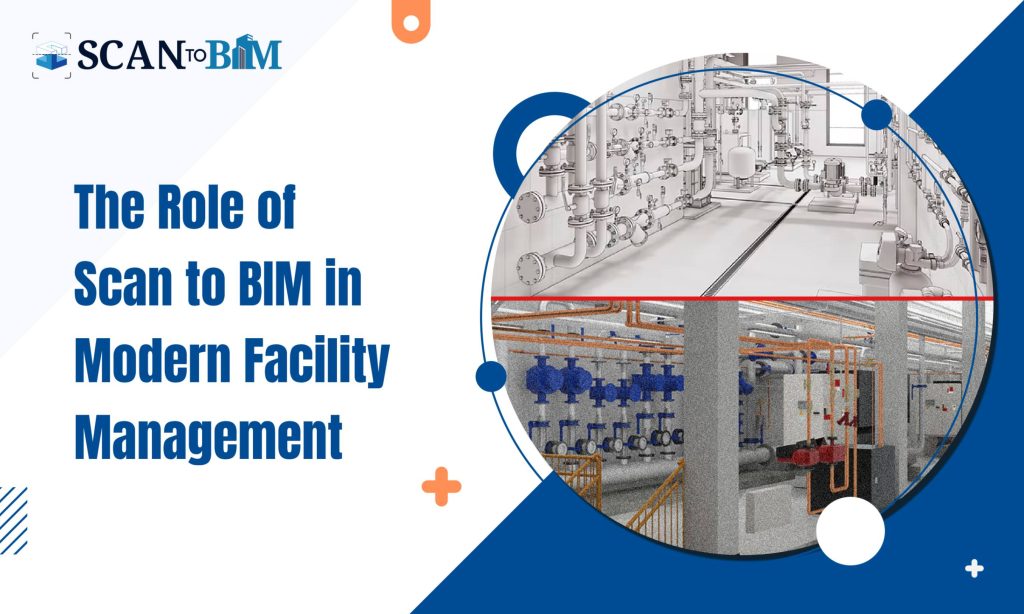
As building operations grow more complex, facility managers and owners are embracing smarter technologies to streamline the maintenance, optimize the resources and future-proof their assets. One of the most impactful advancements in this space is Scan to BIM – a process that transforms the real-world conditions into an intelligent 3D models.
In this blog, we will explore how Scan to BIM is revolutionizing the facility management and why the building owners should consider partnering with an experienced Scan to BIM Company to unlock its full potential.
What Is Scan to BIM?
Scan to BIM involves using 3D laser scanning (LiDAR or photogrammetry) to capture the physical conditions of an existing building and converting that data into a parametric BIM model. This is done by processing the raw point cloud data (millions of spatial data points) into a digital model that accurately reflects the dimensions, geometry and even the building systems.
Also known as Point Cloud to BIM Services, this method is particularly valuable when there are no up-to-date or reliable as-built drawings.
Why Facility Management Needs BIM?
Facility management isn’t just about reactive maintenance—it is about managing the building performance, extending the asset life, minimizing the downtime and ensuring the safety and sustainability. However, most older buildings lack accurate documentation. This leads to inefficiencies, delayed maintenance and higher costs.
Scan to BIM solves these issues by creating a digital twin of the existing structure offering a single source of truth for all the stakeholders.
Top Benefits of Scan to BIM for Facility Management
- Accurate As-Built Documentation
Scan to BIM delivers a true-to-life 3D model of your building—crucial when dealing with the outdated or missing drawings. It offers a reliable foundation for space planning, upgrades and even for the routine facility management tasks.
- Streamlined Maintenance & Repairs
Each building system—electrical, plumbing, HVAC, fire safety can be tagged within the BIM model. This allows the facility teams to locate and troubleshoot issues quickly thereby leading to the faster resolution and reduced downtime.
- Lifecycle Asset Management
With BIM, each asset can be linked to the metadata such as manufacturer details, warranty info and maintenance schedules. This enables the predictive maintenance, reducing the sudden failures and extending the asset life.
- Space Optimization
Whether you’re reallocating the workspaces, planning the retrofits or managing the occupancy, BIM provides a clear spatial overview to make the informed decisions hence helping down to reduce the space wastage and increase the efficiency.
- Energy Efficiency and Sustainability
Integrating BIM with the simulation tools allows the owners to analyze the building performance and identify areas for energy savings—supporting the sustainability goals as well as the green building certifications.
- Cost-Effective Renovations
During remodeling or retrofitting, having a precise digital model helps to avoid the clashes, reduce the reworks and lower the renovation costs. Coordination between the architects, engineers and contractors becomes quite seamless.
- Emergency Planning & Safety
The BIM model can store vital safety data including the fire exits, shut-off valves and hazardous zones which are essential for quick action during the emergencies.
Real-Life Example: Healthcare Facility in Melbourne
A private hospital in Melbourne partnered with a Scan to BIM company to digitize its aging infrastructure which lacked up-to-date documentation. Using the high-resolution 3D laser scanners, the entire facility was captured and converted into a BIM model using the Point Cloud to BIM Services.
Outcomes:
- A centralized asset database linked with their CMMS (Computerized Maintenance Management System)
- Faster HVAC system maintenance along with the real-time asset tracking
- Clear evacuation plans as well as improved regulatory compliance
- Energy audit revealed savings potential of up to 18% by optimizing the lighting and even the insulation zones
This real-world success showcases how Scan to BIM can drive efficiency and also the safety in the critical environments like the healthcare.
Steps to Implement Scan to BIM for Facility Management
- Site Scanning: Use LiDAR scanners or even the drones to capture the existing structure.
- Point Cloud Processing: Clean and segment the scanned data.
- BIM Model Creation: Convert the point clouds data in to a detailed Revit or an IFC model (LOD 300–500).
- System Integration: Link BIM with the CMMS, CAFM or BMS for full facility control.
- Model Training: Make sure that your Facility Management team understands how to use and even maintain the model.
Choosing the right Scan to BIM Company is quite crucial to ensure the accuracy, data richness as well as the software compatibility.
Conclusion
Scan to BIM is more than a technical upgrade—it is a strategic asset that empowers the facility managers and building owners to take control of the operations, reduce the costs and also make sure the performance in long term.
Whether you manage a commercial complex, healthcare facility, school campus or an industrial plant, Point Cloud to BIM services can transform the way your buildings are maintained or even operated.
Ready to Bring Your Building into the Digital Age?
We offer precise and cost-effective Scan to BIM services tailored for the facility management, renovation planning and asset optimization. Build a smarter, more efficient future with us.
Reach out today for a consultation or a sample project demo.